Weight-Related Stigma: Examining Consequences, Nature, and Solutions
VerifiedAdded on 2019/11/12
|10
|3019
|182
Essay
AI Summary
This essay examines the pervasive issue of weight-related stigma, a deeply rooted societal problem that leads to discrimination and prejudice against individuals based on their weight. The essay reviews existing research on the consequences of weight stigma, highlighting its negative impacts on social behaviors and the health of obese individuals, including discrimination in workplaces, educational institutions, and healthcare facilities. It explores the nature of weight stigma, discussing how societal ideals of thinness and media portrayals contribute to negative stereotypes. Furthermore, the essay investigates potential ways to counteract weight-related stigma, emphasizing the importance of promoting health over physical appearance and the effectiveness of social consensus in reducing negative attitudes. The essay concludes by emphasizing the need for further research and societal acceptance to mitigate the harmful effects of weight stigma on both physical and psychological well-being.
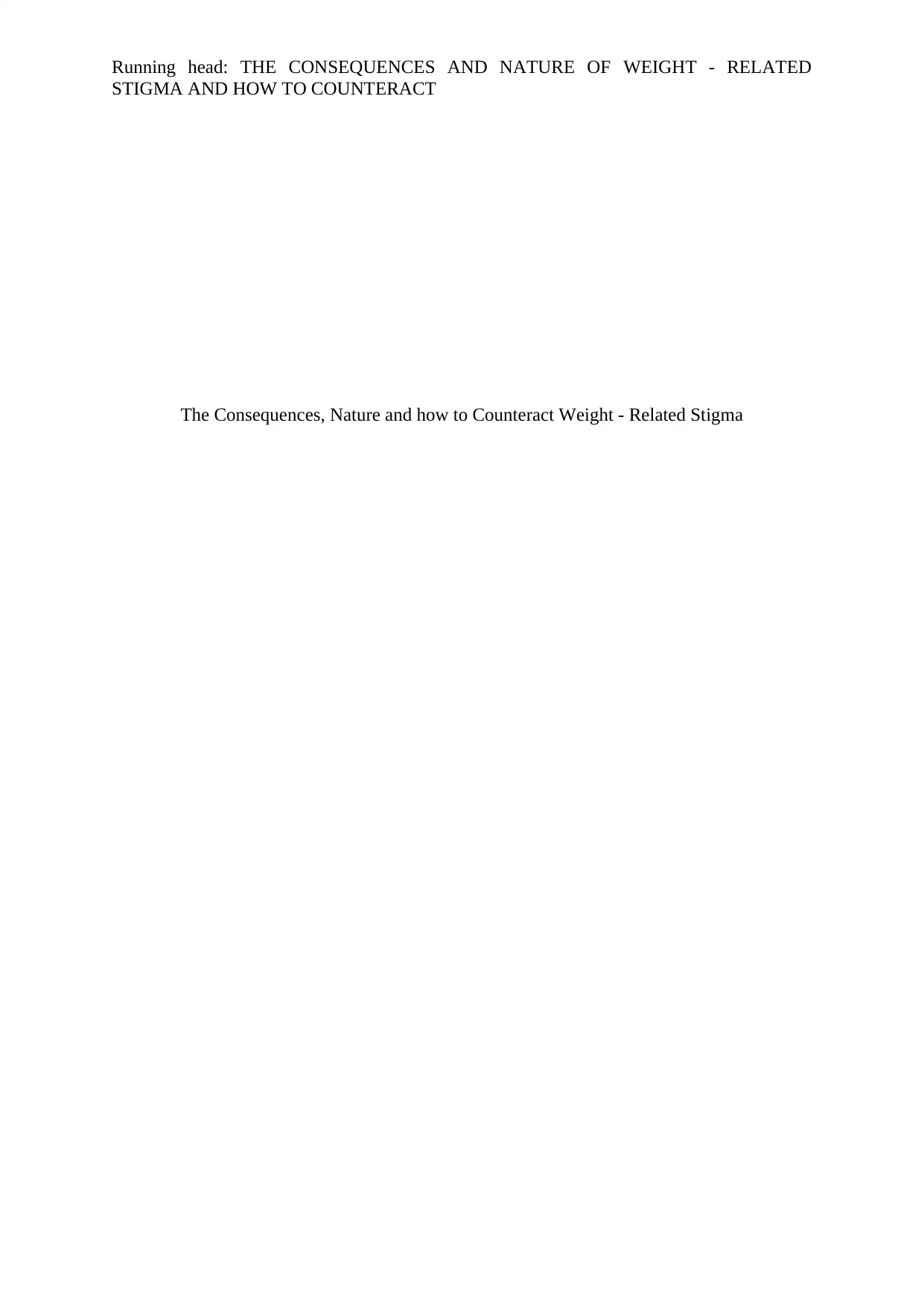
Running head: THE CONSEQUENCES AND NATURE OF WEIGHT - RELATED
STIGMA AND HOW TO COUNTERACT
The Consequences, Nature and how to Counteract Weight - Related Stigma
STIGMA AND HOW TO COUNTERACT
The Consequences, Nature and how to Counteract Weight - Related Stigma
Paraphrase This Document
Need a fresh take? Get an instant paraphrase of this document with our AI Paraphraser
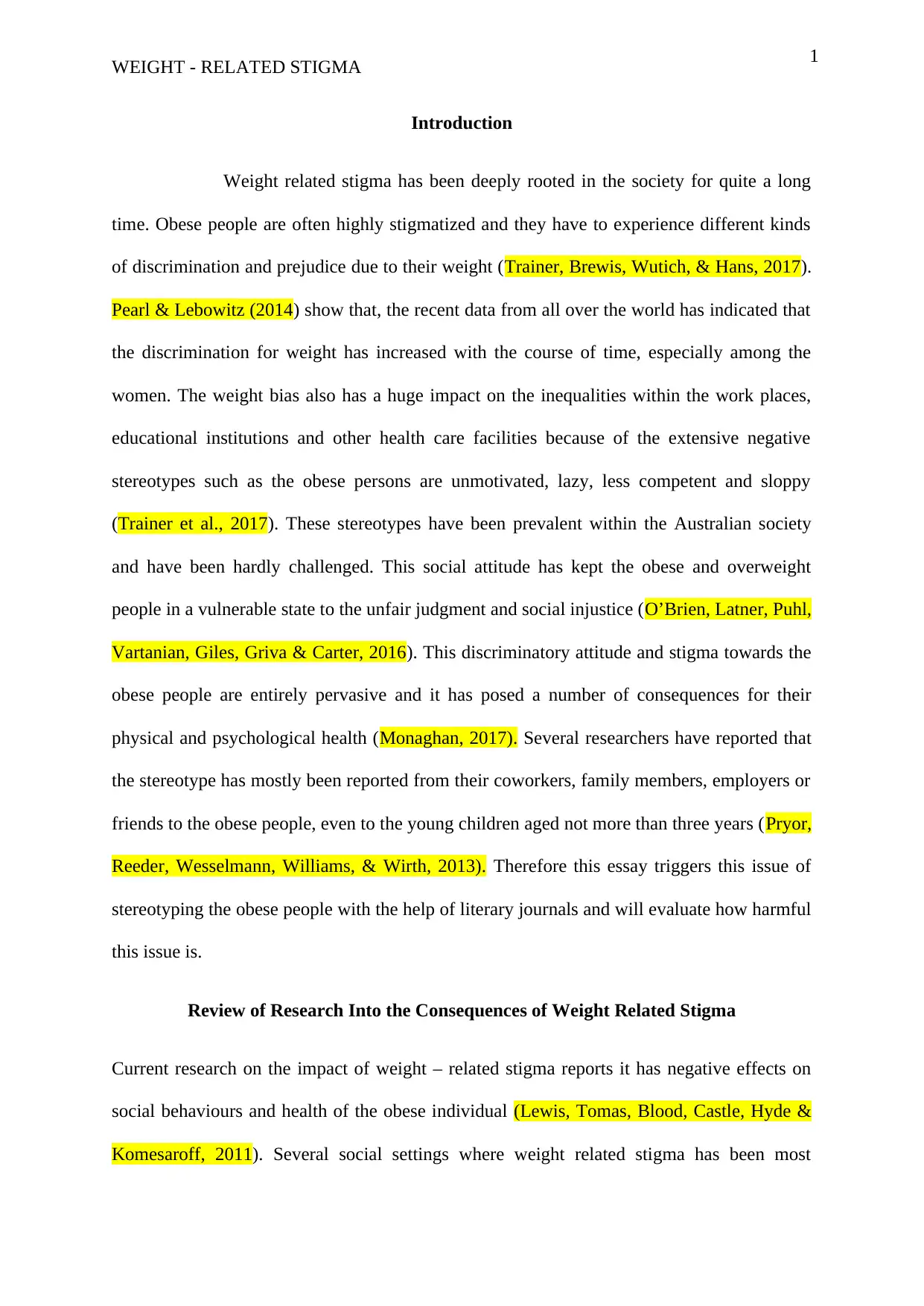
1
WEIGHT - RELATED STIGMA
Introduction
Weight related stigma has been deeply rooted in the society for quite a long
time. Obese people are often highly stigmatized and they have to experience different kinds
of discrimination and prejudice due to their weight (Trainer, Brewis, Wutich, & Hans, 2017).
Pearl & Lebowitz (2014) show that, the recent data from all over the world has indicated that
the discrimination for weight has increased with the course of time, especially among the
women. The weight bias also has a huge impact on the inequalities within the work places,
educational institutions and other health care facilities because of the extensive negative
stereotypes such as the obese persons are unmotivated, lazy, less competent and sloppy
(Trainer et al., 2017). These stereotypes have been prevalent within the Australian society
and have been hardly challenged. This social attitude has kept the obese and overweight
people in a vulnerable state to the unfair judgment and social injustice (O’Brien, Latner, Puhl,
Vartanian, Giles, Griva & Carter, 2016). This discriminatory attitude and stigma towards the
obese people are entirely pervasive and it has posed a number of consequences for their
physical and psychological health (Monaghan, 2017). Several researchers have reported that
the stereotype has mostly been reported from their coworkers, family members, employers or
friends to the obese people, even to the young children aged not more than three years (Pryor,
Reeder, Wesselmann, Williams, & Wirth, 2013). Therefore this essay triggers this issue of
stereotyping the obese people with the help of literary journals and will evaluate how harmful
this issue is.
Review of Research Into the Consequences of Weight Related Stigma
Current research on the impact of weight – related stigma reports it has negative effects on
social behaviours and health of the obese individual (Lewis, Tomas, Blood, Castle, Hyde &
Komesaroff, 2011). Several social settings where weight related stigma has been most
WEIGHT - RELATED STIGMA
Introduction
Weight related stigma has been deeply rooted in the society for quite a long
time. Obese people are often highly stigmatized and they have to experience different kinds
of discrimination and prejudice due to their weight (Trainer, Brewis, Wutich, & Hans, 2017).
Pearl & Lebowitz (2014) show that, the recent data from all over the world has indicated that
the discrimination for weight has increased with the course of time, especially among the
women. The weight bias also has a huge impact on the inequalities within the work places,
educational institutions and other health care facilities because of the extensive negative
stereotypes such as the obese persons are unmotivated, lazy, less competent and sloppy
(Trainer et al., 2017). These stereotypes have been prevalent within the Australian society
and have been hardly challenged. This social attitude has kept the obese and overweight
people in a vulnerable state to the unfair judgment and social injustice (O’Brien, Latner, Puhl,
Vartanian, Giles, Griva & Carter, 2016). This discriminatory attitude and stigma towards the
obese people are entirely pervasive and it has posed a number of consequences for their
physical and psychological health (Monaghan, 2017). Several researchers have reported that
the stereotype has mostly been reported from their coworkers, family members, employers or
friends to the obese people, even to the young children aged not more than three years (Pryor,
Reeder, Wesselmann, Williams, & Wirth, 2013). Therefore this essay triggers this issue of
stereotyping the obese people with the help of literary journals and will evaluate how harmful
this issue is.
Review of Research Into the Consequences of Weight Related Stigma
Current research on the impact of weight – related stigma reports it has negative effects on
social behaviours and health of the obese individual (Lewis, Tomas, Blood, Castle, Hyde &
Komesaroff, 2011). Several social settings where weight related stigma has been most
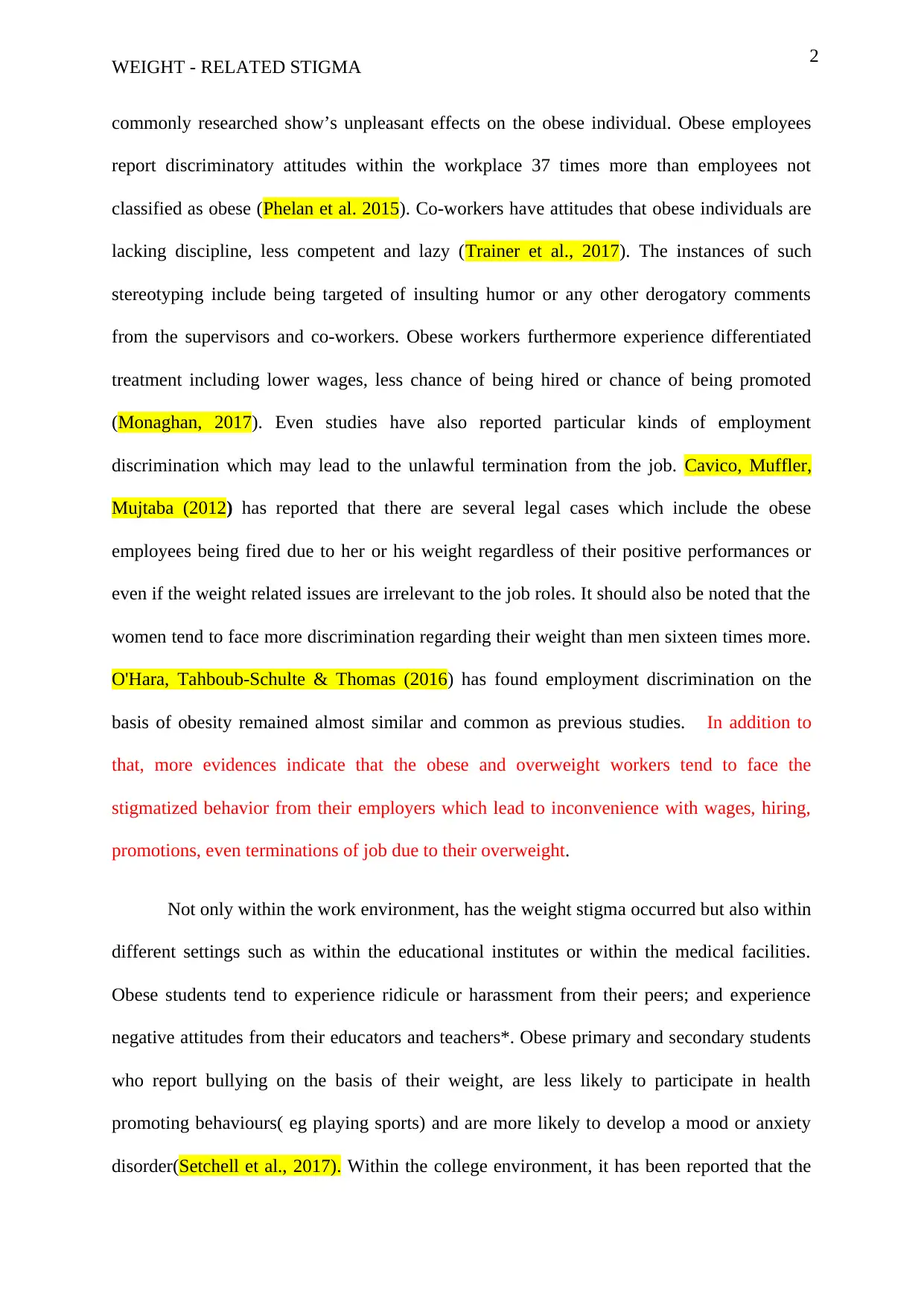
2
WEIGHT - RELATED STIGMA
commonly researched show’s unpleasant effects on the obese individual. Obese employees
report discriminatory attitudes within the workplace 37 times more than employees not
classified as obese (Phelan et al. 2015). Co-workers have attitudes that obese individuals are
lacking discipline, less competent and lazy (Trainer et al., 2017). The instances of such
stereotyping include being targeted of insulting humor or any other derogatory comments
from the supervisors and co-workers. Obese workers furthermore experience differentiated
treatment including lower wages, less chance of being hired or chance of being promoted
(Monaghan, 2017). Even studies have also reported particular kinds of employment
discrimination which may lead to the unlawful termination from the job. Cavico, Muffler,
Mujtaba (2012) has reported that there are several legal cases which include the obese
employees being fired due to her or his weight regardless of their positive performances or
even if the weight related issues are irrelevant to the job roles. It should also be noted that the
women tend to face more discrimination regarding their weight than men sixteen times more.
O'Hara, Tahboub-Schulte & Thomas (2016) has found employment discrimination on the
basis of obesity remained almost similar and common as previous studies. In addition to
that, more evidences indicate that the obese and overweight workers tend to face the
stigmatized behavior from their employers which lead to inconvenience with wages, hiring,
promotions, even terminations of job due to their overweight.
Not only within the work environment, has the weight stigma occurred but also within
different settings such as within the educational institutes or within the medical facilities.
Obese students tend to experience ridicule or harassment from their peers; and experience
negative attitudes from their educators and teachers*. Obese primary and secondary students
who report bullying on the basis of their weight, are less likely to participate in health
promoting behaviours( eg playing sports) and are more likely to develop a mood or anxiety
disorder(Setchell et al., 2017). Within the college environment, it has been reported that the
WEIGHT - RELATED STIGMA
commonly researched show’s unpleasant effects on the obese individual. Obese employees
report discriminatory attitudes within the workplace 37 times more than employees not
classified as obese (Phelan et al. 2015). Co-workers have attitudes that obese individuals are
lacking discipline, less competent and lazy (Trainer et al., 2017). The instances of such
stereotyping include being targeted of insulting humor or any other derogatory comments
from the supervisors and co-workers. Obese workers furthermore experience differentiated
treatment including lower wages, less chance of being hired or chance of being promoted
(Monaghan, 2017). Even studies have also reported particular kinds of employment
discrimination which may lead to the unlawful termination from the job. Cavico, Muffler,
Mujtaba (2012) has reported that there are several legal cases which include the obese
employees being fired due to her or his weight regardless of their positive performances or
even if the weight related issues are irrelevant to the job roles. It should also be noted that the
women tend to face more discrimination regarding their weight than men sixteen times more.
O'Hara, Tahboub-Schulte & Thomas (2016) has found employment discrimination on the
basis of obesity remained almost similar and common as previous studies. In addition to
that, more evidences indicate that the obese and overweight workers tend to face the
stigmatized behavior from their employers which lead to inconvenience with wages, hiring,
promotions, even terminations of job due to their overweight.
Not only within the work environment, has the weight stigma occurred but also within
different settings such as within the educational institutes or within the medical facilities.
Obese students tend to experience ridicule or harassment from their peers; and experience
negative attitudes from their educators and teachers*. Obese primary and secondary students
who report bullying on the basis of their weight, are less likely to participate in health
promoting behaviours( eg playing sports) and are more likely to develop a mood or anxiety
disorder(Setchell et al., 2017). Within the college environment, it has been reported that the
⊘ This is a preview!⊘
Do you want full access?
Subscribe today to unlock all pages.

Trusted by 1+ million students worldwide
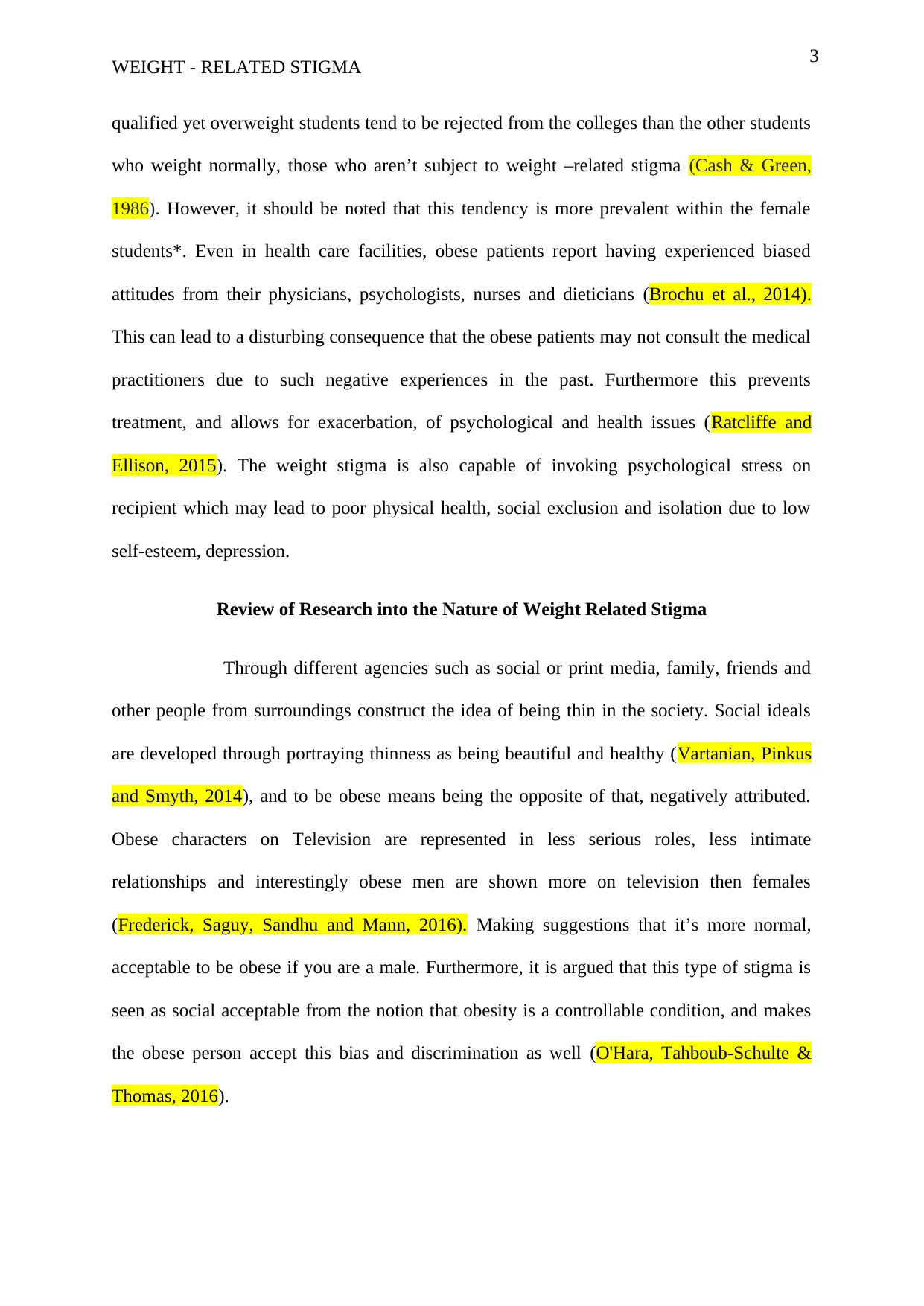
3
WEIGHT - RELATED STIGMA
qualified yet overweight students tend to be rejected from the colleges than the other students
who weight normally, those who aren’t subject to weight –related stigma (Cash & Green,
1986). However, it should be noted that this tendency is more prevalent within the female
students*. Even in health care facilities, obese patients report having experienced biased
attitudes from their physicians, psychologists, nurses and dieticians (Brochu et al., 2014).
This can lead to a disturbing consequence that the obese patients may not consult the medical
practitioners due to such negative experiences in the past. Furthermore this prevents
treatment, and allows for exacerbation, of psychological and health issues (Ratcliffe and
Ellison, 2015). The weight stigma is also capable of invoking psychological stress on
recipient which may lead to poor physical health, social exclusion and isolation due to low
self-esteem, depression.
Review of Research into the Nature of Weight Related Stigma
Through different agencies such as social or print media, family, friends and
other people from surroundings construct the idea of being thin in the society. Social ideals
are developed through portraying thinness as being beautiful and healthy (Vartanian, Pinkus
and Smyth, 2014), and to be obese means being the opposite of that, negatively attributed.
Obese characters on Television are represented in less serious roles, less intimate
relationships and interestingly obese men are shown more on television then females
(Frederick, Saguy, Sandhu and Mann, 2016). Making suggestions that it’s more normal,
acceptable to be obese if you are a male. Furthermore, it is argued that this type of stigma is
seen as social acceptable from the notion that obesity is a controllable condition, and makes
the obese person accept this bias and discrimination as well (O'Hara, Tahboub-Schulte &
Thomas, 2016).
WEIGHT - RELATED STIGMA
qualified yet overweight students tend to be rejected from the colleges than the other students
who weight normally, those who aren’t subject to weight –related stigma (Cash & Green,
1986). However, it should be noted that this tendency is more prevalent within the female
students*. Even in health care facilities, obese patients report having experienced biased
attitudes from their physicians, psychologists, nurses and dieticians (Brochu et al., 2014).
This can lead to a disturbing consequence that the obese patients may not consult the medical
practitioners due to such negative experiences in the past. Furthermore this prevents
treatment, and allows for exacerbation, of psychological and health issues (Ratcliffe and
Ellison, 2015). The weight stigma is also capable of invoking psychological stress on
recipient which may lead to poor physical health, social exclusion and isolation due to low
self-esteem, depression.
Review of Research into the Nature of Weight Related Stigma
Through different agencies such as social or print media, family, friends and
other people from surroundings construct the idea of being thin in the society. Social ideals
are developed through portraying thinness as being beautiful and healthy (Vartanian, Pinkus
and Smyth, 2014), and to be obese means being the opposite of that, negatively attributed.
Obese characters on Television are represented in less serious roles, less intimate
relationships and interestingly obese men are shown more on television then females
(Frederick, Saguy, Sandhu and Mann, 2016). Making suggestions that it’s more normal,
acceptable to be obese if you are a male. Furthermore, it is argued that this type of stigma is
seen as social acceptable from the notion that obesity is a controllable condition, and makes
the obese person accept this bias and discrimination as well (O'Hara, Tahboub-Schulte &
Thomas, 2016).
Paraphrase This Document
Need a fresh take? Get an instant paraphrase of this document with our AI Paraphraser
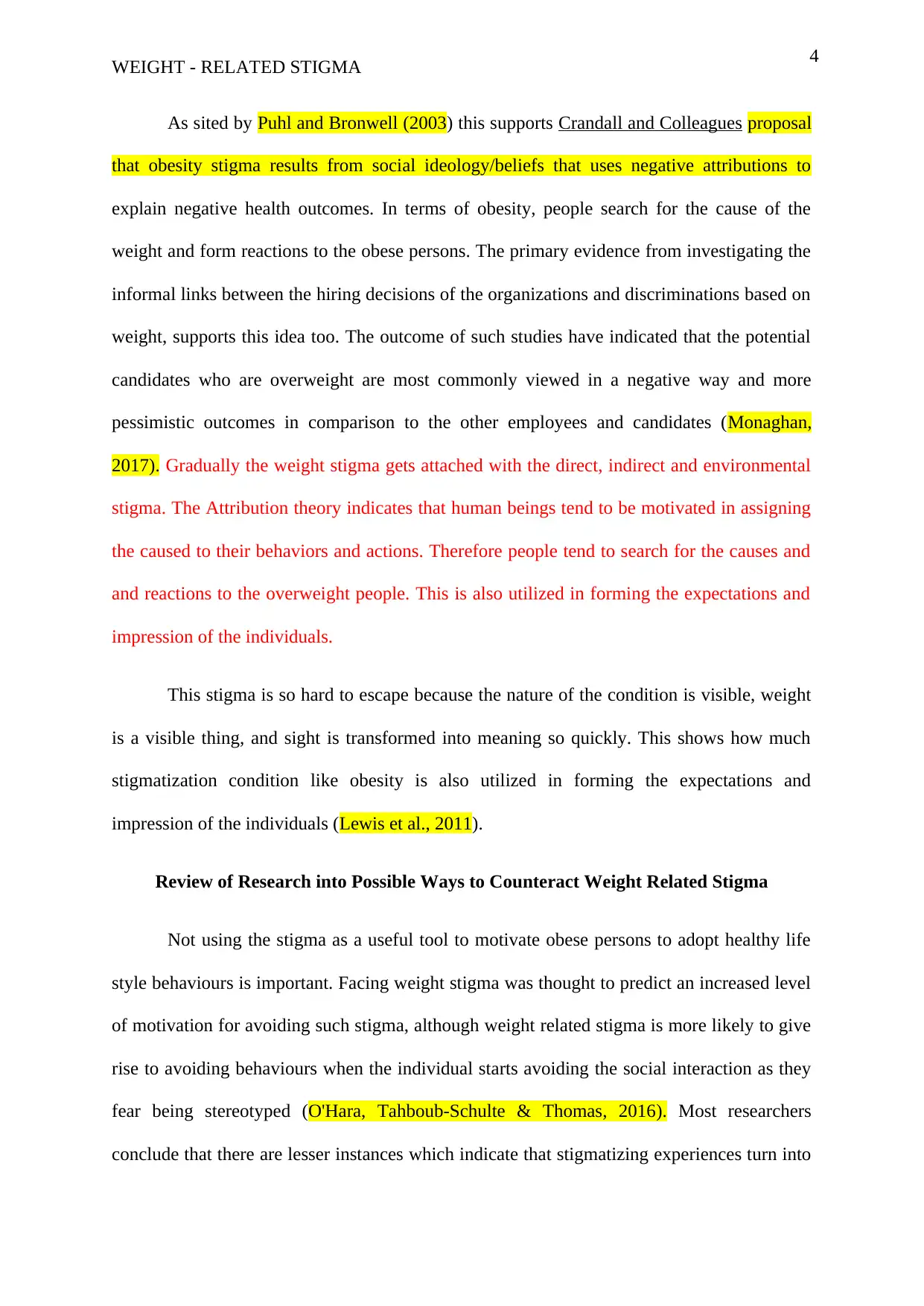
4
WEIGHT - RELATED STIGMA
As sited by Puhl and Bronwell (2003) this supports Crandall and Colleagues proposal
that obesity stigma results from social ideology/beliefs that uses negative attributions to
explain negative health outcomes. In terms of obesity, people search for the cause of the
weight and form reactions to the obese persons. The primary evidence from investigating the
informal links between the hiring decisions of the organizations and discriminations based on
weight, supports this idea too. The outcome of such studies have indicated that the potential
candidates who are overweight are most commonly viewed in a negative way and more
pessimistic outcomes in comparison to the other employees and candidates (Monaghan,
2017). Gradually the weight stigma gets attached with the direct, indirect and environmental
stigma. The Attribution theory indicates that human beings tend to be motivated in assigning
the caused to their behaviors and actions. Therefore people tend to search for the causes and
and reactions to the overweight people. This is also utilized in forming the expectations and
impression of the individuals.
This stigma is so hard to escape because the nature of the condition is visible, weight
is a visible thing, and sight is transformed into meaning so quickly. This shows how much
stigmatization condition like obesity is also utilized in forming the expectations and
impression of the individuals (Lewis et al., 2011).
Review of Research into Possible Ways to Counteract Weight Related Stigma
Not using the stigma as a useful tool to motivate obese persons to adopt healthy life
style behaviours is important. Facing weight stigma was thought to predict an increased level
of motivation for avoiding such stigma, although weight related stigma is more likely to give
rise to avoiding behaviours when the individual starts avoiding the social interaction as they
fear being stereotyped (O'Hara, Tahboub-Schulte & Thomas, 2016). Most researchers
conclude that there are lesser instances which indicate that stigmatizing experiences turn into
WEIGHT - RELATED STIGMA
As sited by Puhl and Bronwell (2003) this supports Crandall and Colleagues proposal
that obesity stigma results from social ideology/beliefs that uses negative attributions to
explain negative health outcomes. In terms of obesity, people search for the cause of the
weight and form reactions to the obese persons. The primary evidence from investigating the
informal links between the hiring decisions of the organizations and discriminations based on
weight, supports this idea too. The outcome of such studies have indicated that the potential
candidates who are overweight are most commonly viewed in a negative way and more
pessimistic outcomes in comparison to the other employees and candidates (Monaghan,
2017). Gradually the weight stigma gets attached with the direct, indirect and environmental
stigma. The Attribution theory indicates that human beings tend to be motivated in assigning
the caused to their behaviors and actions. Therefore people tend to search for the causes and
and reactions to the overweight people. This is also utilized in forming the expectations and
impression of the individuals.
This stigma is so hard to escape because the nature of the condition is visible, weight
is a visible thing, and sight is transformed into meaning so quickly. This shows how much
stigmatization condition like obesity is also utilized in forming the expectations and
impression of the individuals (Lewis et al., 2011).
Review of Research into Possible Ways to Counteract Weight Related Stigma
Not using the stigma as a useful tool to motivate obese persons to adopt healthy life
style behaviours is important. Facing weight stigma was thought to predict an increased level
of motivation for avoiding such stigma, although weight related stigma is more likely to give
rise to avoiding behaviours when the individual starts avoiding the social interaction as they
fear being stereotyped (O'Hara, Tahboub-Schulte & Thomas, 2016). Most researchers
conclude that there are lesser instances which indicate that stigmatizing experiences turn into
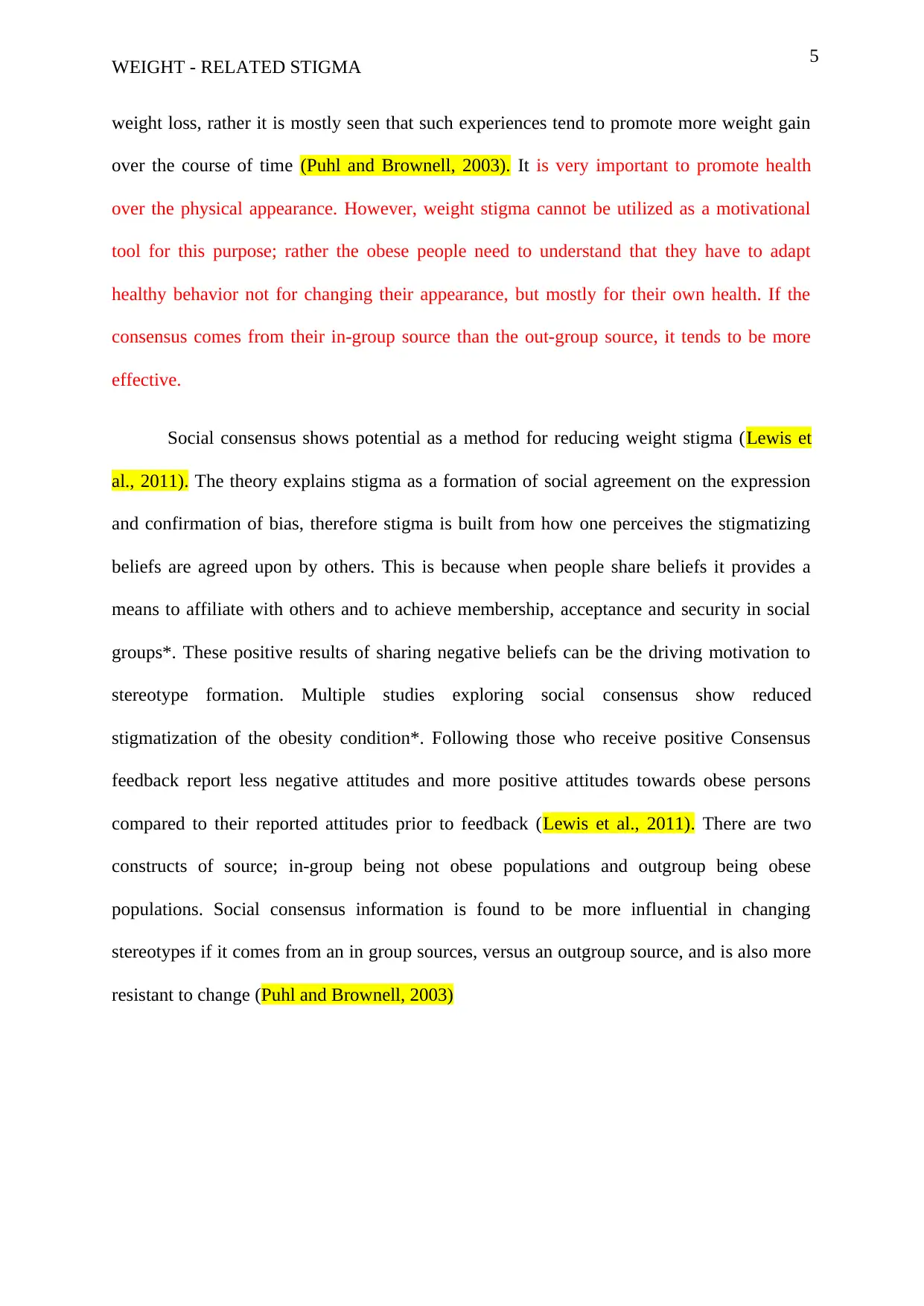
5
WEIGHT - RELATED STIGMA
weight loss, rather it is mostly seen that such experiences tend to promote more weight gain
over the course of time (Puhl and Brownell, 2003). It is very important to promote health
over the physical appearance. However, weight stigma cannot be utilized as a motivational
tool for this purpose; rather the obese people need to understand that they have to adapt
healthy behavior not for changing their appearance, but mostly for their own health. If the
consensus comes from their in-group source than the out-group source, it tends to be more
effective.
Social consensus shows potential as a method for reducing weight stigma (Lewis et
al., 2011). The theory explains stigma as a formation of social agreement on the expression
and confirmation of bias, therefore stigma is built from how one perceives the stigmatizing
beliefs are agreed upon by others. This is because when people share beliefs it provides a
means to affiliate with others and to achieve membership, acceptance and security in social
groups*. These positive results of sharing negative beliefs can be the driving motivation to
stereotype formation. Multiple studies exploring social consensus show reduced
stigmatization of the obesity condition*. Following those who receive positive Consensus
feedback report less negative attitudes and more positive attitudes towards obese persons
compared to their reported attitudes prior to feedback (Lewis et al., 2011). There are two
constructs of source; in-group being not obese populations and outgroup being obese
populations. Social consensus information is found to be more influential in changing
stereotypes if it comes from an in group sources, versus an outgroup source, and is also more
resistant to change (Puhl and Brownell, 2003)
WEIGHT - RELATED STIGMA
weight loss, rather it is mostly seen that such experiences tend to promote more weight gain
over the course of time (Puhl and Brownell, 2003). It is very important to promote health
over the physical appearance. However, weight stigma cannot be utilized as a motivational
tool for this purpose; rather the obese people need to understand that they have to adapt
healthy behavior not for changing their appearance, but mostly for their own health. If the
consensus comes from their in-group source than the out-group source, it tends to be more
effective.
Social consensus shows potential as a method for reducing weight stigma (Lewis et
al., 2011). The theory explains stigma as a formation of social agreement on the expression
and confirmation of bias, therefore stigma is built from how one perceives the stigmatizing
beliefs are agreed upon by others. This is because when people share beliefs it provides a
means to affiliate with others and to achieve membership, acceptance and security in social
groups*. These positive results of sharing negative beliefs can be the driving motivation to
stereotype formation. Multiple studies exploring social consensus show reduced
stigmatization of the obesity condition*. Following those who receive positive Consensus
feedback report less negative attitudes and more positive attitudes towards obese persons
compared to their reported attitudes prior to feedback (Lewis et al., 2011). There are two
constructs of source; in-group being not obese populations and outgroup being obese
populations. Social consensus information is found to be more influential in changing
stereotypes if it comes from an in group sources, versus an outgroup source, and is also more
resistant to change (Puhl and Brownell, 2003)
⊘ This is a preview!⊘
Do you want full access?
Subscribe today to unlock all pages.

Trusted by 1+ million students worldwide
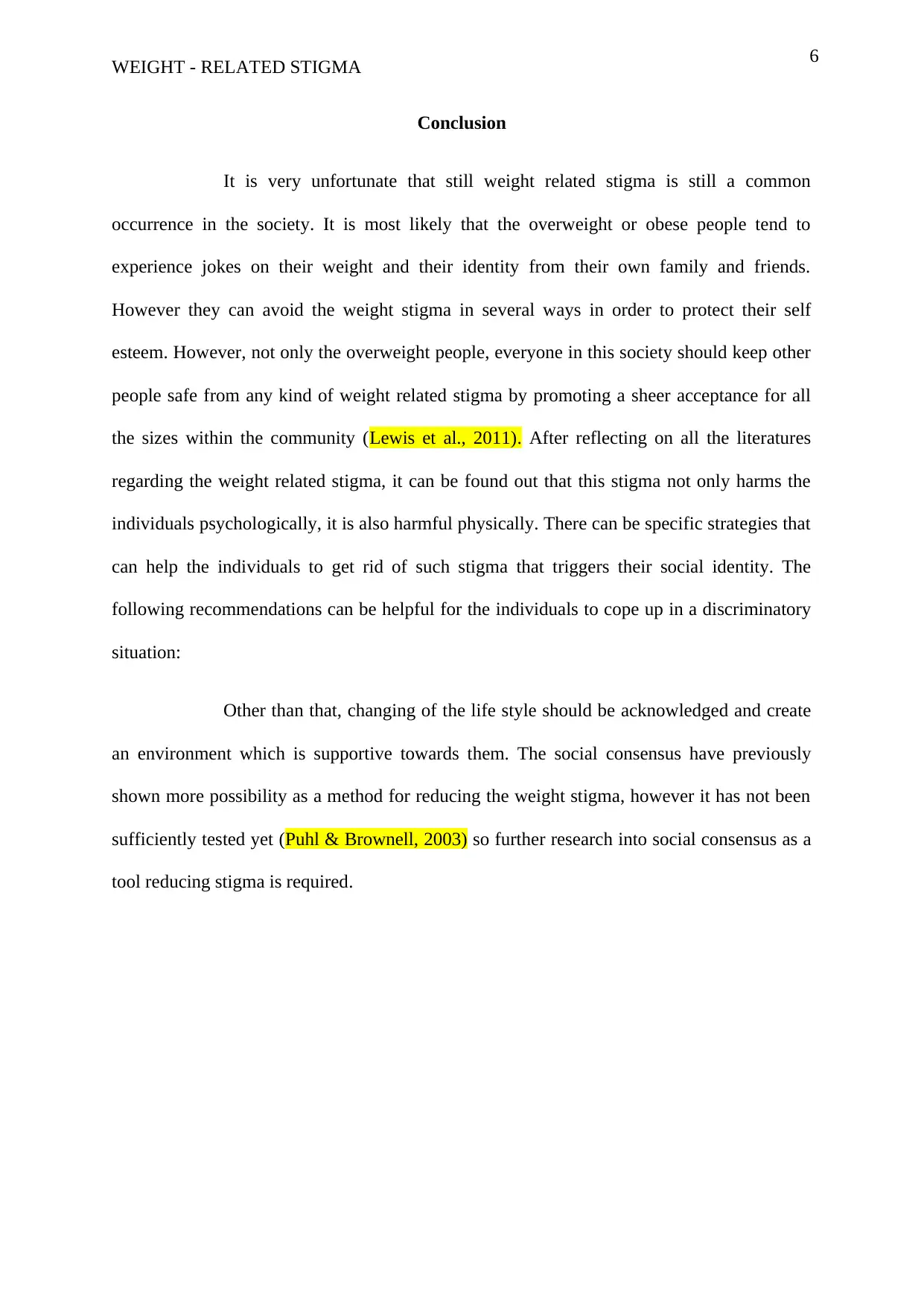
6
WEIGHT - RELATED STIGMA
Conclusion
It is very unfortunate that still weight related stigma is still a common
occurrence in the society. It is most likely that the overweight or obese people tend to
experience jokes on their weight and their identity from their own family and friends.
However they can avoid the weight stigma in several ways in order to protect their self
esteem. However, not only the overweight people, everyone in this society should keep other
people safe from any kind of weight related stigma by promoting a sheer acceptance for all
the sizes within the community (Lewis et al., 2011). After reflecting on all the literatures
regarding the weight related stigma, it can be found out that this stigma not only harms the
individuals psychologically, it is also harmful physically. There can be specific strategies that
can help the individuals to get rid of such stigma that triggers their social identity. The
following recommendations can be helpful for the individuals to cope up in a discriminatory
situation:
Other than that, changing of the life style should be acknowledged and create
an environment which is supportive towards them. The social consensus have previously
shown more possibility as a method for reducing the weight stigma, however it has not been
sufficiently tested yet (Puhl & Brownell, 2003) so further research into social consensus as a
tool reducing stigma is required.
WEIGHT - RELATED STIGMA
Conclusion
It is very unfortunate that still weight related stigma is still a common
occurrence in the society. It is most likely that the overweight or obese people tend to
experience jokes on their weight and their identity from their own family and friends.
However they can avoid the weight stigma in several ways in order to protect their self
esteem. However, not only the overweight people, everyone in this society should keep other
people safe from any kind of weight related stigma by promoting a sheer acceptance for all
the sizes within the community (Lewis et al., 2011). After reflecting on all the literatures
regarding the weight related stigma, it can be found out that this stigma not only harms the
individuals psychologically, it is also harmful physically. There can be specific strategies that
can help the individuals to get rid of such stigma that triggers their social identity. The
following recommendations can be helpful for the individuals to cope up in a discriminatory
situation:
Other than that, changing of the life style should be acknowledged and create
an environment which is supportive towards them. The social consensus have previously
shown more possibility as a method for reducing the weight stigma, however it has not been
sufficiently tested yet (Puhl & Brownell, 2003) so further research into social consensus as a
tool reducing stigma is required.
Paraphrase This Document
Need a fresh take? Get an instant paraphrase of this document with our AI Paraphraser
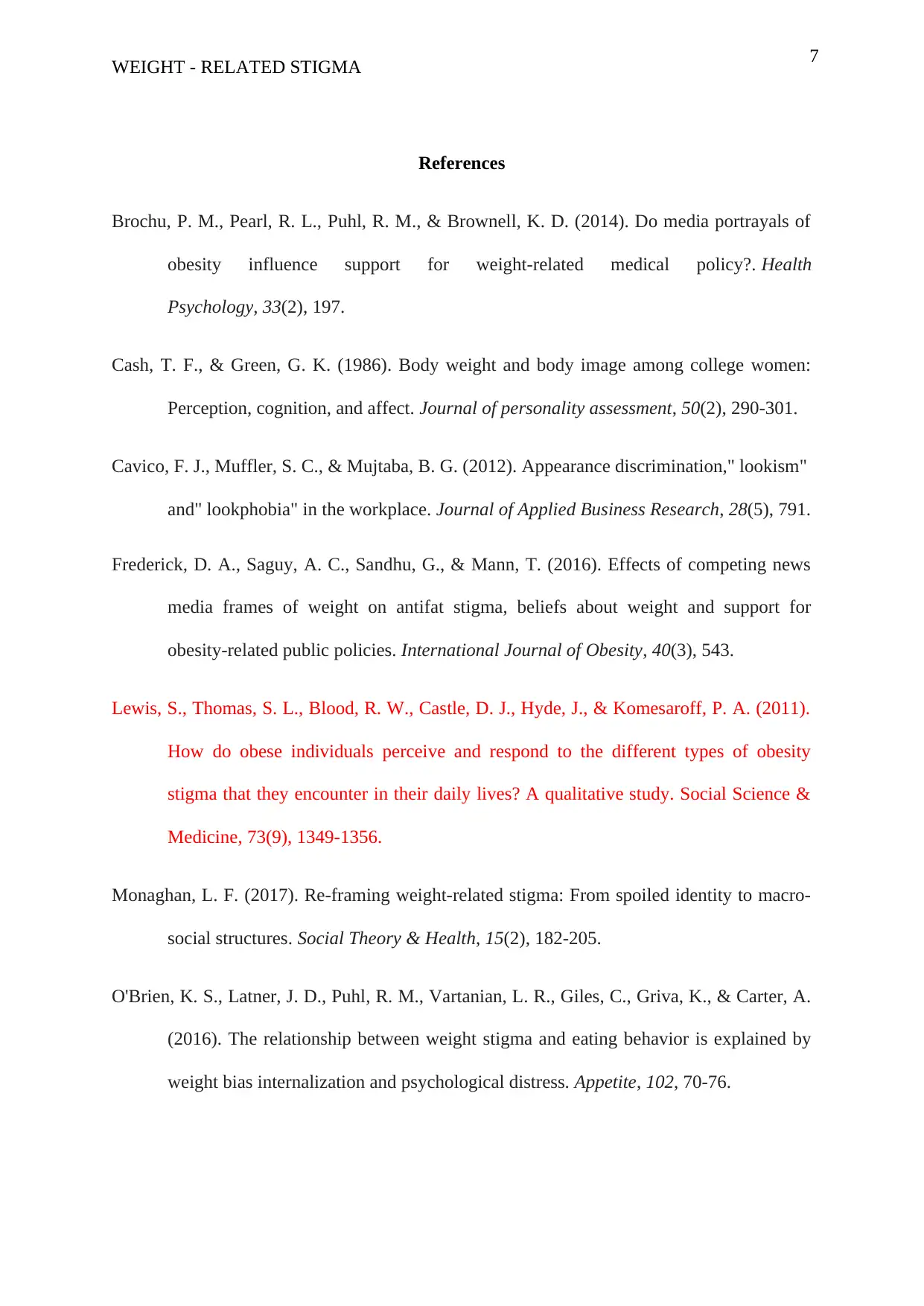
7
WEIGHT - RELATED STIGMA
References
Brochu, P. M., Pearl, R. L., Puhl, R. M., & Brownell, K. D. (2014). Do media portrayals of
obesity influence support for weight-related medical policy?. Health
Psychology, 33(2), 197.
Cash, T. F., & Green, G. K. (1986). Body weight and body image among college women:
Perception, cognition, and affect. Journal of personality assessment, 50(2), 290-301.
Cavico, F. J., Muffler, S. C., & Mujtaba, B. G. (2012). Appearance discrimination," lookism"
and" lookphobia" in the workplace. Journal of Applied Business Research, 28(5), 791.
Frederick, D. A., Saguy, A. C., Sandhu, G., & Mann, T. (2016). Effects of competing news
media frames of weight on antifat stigma, beliefs about weight and support for
obesity-related public policies. International Journal of Obesity, 40(3), 543.
Lewis, S., Thomas, S. L., Blood, R. W., Castle, D. J., Hyde, J., & Komesaroff, P. A. (2011).
How do obese individuals perceive and respond to the different types of obesity
stigma that they encounter in their daily lives? A qualitative study. Social Science &
Medicine, 73(9), 1349-1356.
Monaghan, L. F. (2017). Re-framing weight-related stigma: From spoiled identity to macro-
social structures. Social Theory & Health, 15(2), 182-205.
O'Brien, K. S., Latner, J. D., Puhl, R. M., Vartanian, L. R., Giles, C., Griva, K., & Carter, A.
(2016). The relationship between weight stigma and eating behavior is explained by
weight bias internalization and psychological distress. Appetite, 102, 70-76.
WEIGHT - RELATED STIGMA
References
Brochu, P. M., Pearl, R. L., Puhl, R. M., & Brownell, K. D. (2014). Do media portrayals of
obesity influence support for weight-related medical policy?. Health
Psychology, 33(2), 197.
Cash, T. F., & Green, G. K. (1986). Body weight and body image among college women:
Perception, cognition, and affect. Journal of personality assessment, 50(2), 290-301.
Cavico, F. J., Muffler, S. C., & Mujtaba, B. G. (2012). Appearance discrimination," lookism"
and" lookphobia" in the workplace. Journal of Applied Business Research, 28(5), 791.
Frederick, D. A., Saguy, A. C., Sandhu, G., & Mann, T. (2016). Effects of competing news
media frames of weight on antifat stigma, beliefs about weight and support for
obesity-related public policies. International Journal of Obesity, 40(3), 543.
Lewis, S., Thomas, S. L., Blood, R. W., Castle, D. J., Hyde, J., & Komesaroff, P. A. (2011).
How do obese individuals perceive and respond to the different types of obesity
stigma that they encounter in their daily lives? A qualitative study. Social Science &
Medicine, 73(9), 1349-1356.
Monaghan, L. F. (2017). Re-framing weight-related stigma: From spoiled identity to macro-
social structures. Social Theory & Health, 15(2), 182-205.
O'Brien, K. S., Latner, J. D., Puhl, R. M., Vartanian, L. R., Giles, C., Griva, K., & Carter, A.
(2016). The relationship between weight stigma and eating behavior is explained by
weight bias internalization and psychological distress. Appetite, 102, 70-76.
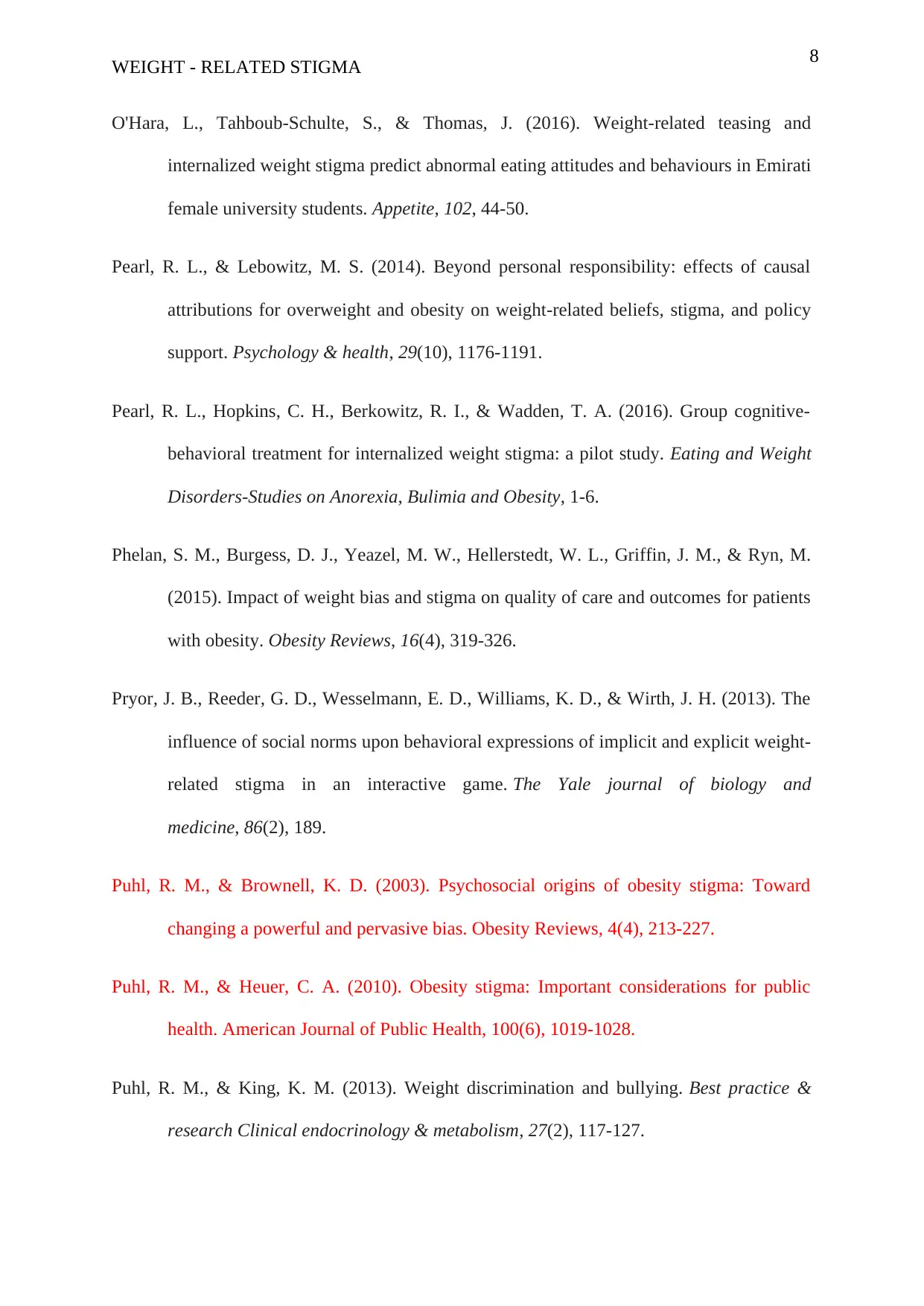
8
WEIGHT - RELATED STIGMA
O'Hara, L., Tahboub-Schulte, S., & Thomas, J. (2016). Weight-related teasing and
internalized weight stigma predict abnormal eating attitudes and behaviours in Emirati
female university students. Appetite, 102, 44-50.
Pearl, R. L., & Lebowitz, M. S. (2014). Beyond personal responsibility: effects of causal
attributions for overweight and obesity on weight-related beliefs, stigma, and policy
support. Psychology & health, 29(10), 1176-1191.
Pearl, R. L., Hopkins, C. H., Berkowitz, R. I., & Wadden, T. A. (2016). Group cognitive-
behavioral treatment for internalized weight stigma: a pilot study. Eating and Weight
Disorders-Studies on Anorexia, Bulimia and Obesity, 1-6.
Phelan, S. M., Burgess, D. J., Yeazel, M. W., Hellerstedt, W. L., Griffin, J. M., & Ryn, M.
(2015). Impact of weight bias and stigma on quality of care and outcomes for patients
with obesity. Obesity Reviews, 16(4), 319-326.
Pryor, J. B., Reeder, G. D., Wesselmann, E. D., Williams, K. D., & Wirth, J. H. (2013). The
influence of social norms upon behavioral expressions of implicit and explicit weight-
related stigma in an interactive game. The Yale journal of biology and
medicine, 86(2), 189.
Puhl, R. M., & Brownell, K. D. (2003). Psychosocial origins of obesity stigma: Toward
changing a powerful and pervasive bias. Obesity Reviews, 4(4), 213-227.
Puhl, R. M., & Heuer, C. A. (2010). Obesity stigma: Important considerations for public
health. American Journal of Public Health, 100(6), 1019-1028.
Puhl, R. M., & King, K. M. (2013). Weight discrimination and bullying. Best practice &
research Clinical endocrinology & metabolism, 27(2), 117-127.
WEIGHT - RELATED STIGMA
O'Hara, L., Tahboub-Schulte, S., & Thomas, J. (2016). Weight-related teasing and
internalized weight stigma predict abnormal eating attitudes and behaviours in Emirati
female university students. Appetite, 102, 44-50.
Pearl, R. L., & Lebowitz, M. S. (2014). Beyond personal responsibility: effects of causal
attributions for overweight and obesity on weight-related beliefs, stigma, and policy
support. Psychology & health, 29(10), 1176-1191.
Pearl, R. L., Hopkins, C. H., Berkowitz, R. I., & Wadden, T. A. (2016). Group cognitive-
behavioral treatment for internalized weight stigma: a pilot study. Eating and Weight
Disorders-Studies on Anorexia, Bulimia and Obesity, 1-6.
Phelan, S. M., Burgess, D. J., Yeazel, M. W., Hellerstedt, W. L., Griffin, J. M., & Ryn, M.
(2015). Impact of weight bias and stigma on quality of care and outcomes for patients
with obesity. Obesity Reviews, 16(4), 319-326.
Pryor, J. B., Reeder, G. D., Wesselmann, E. D., Williams, K. D., & Wirth, J. H. (2013). The
influence of social norms upon behavioral expressions of implicit and explicit weight-
related stigma in an interactive game. The Yale journal of biology and
medicine, 86(2), 189.
Puhl, R. M., & Brownell, K. D. (2003). Psychosocial origins of obesity stigma: Toward
changing a powerful and pervasive bias. Obesity Reviews, 4(4), 213-227.
Puhl, R. M., & Heuer, C. A. (2010). Obesity stigma: Important considerations for public
health. American Journal of Public Health, 100(6), 1019-1028.
Puhl, R. M., & King, K. M. (2013). Weight discrimination and bullying. Best practice &
research Clinical endocrinology & metabolism, 27(2), 117-127.
⊘ This is a preview!⊘
Do you want full access?
Subscribe today to unlock all pages.

Trusted by 1+ million students worldwide
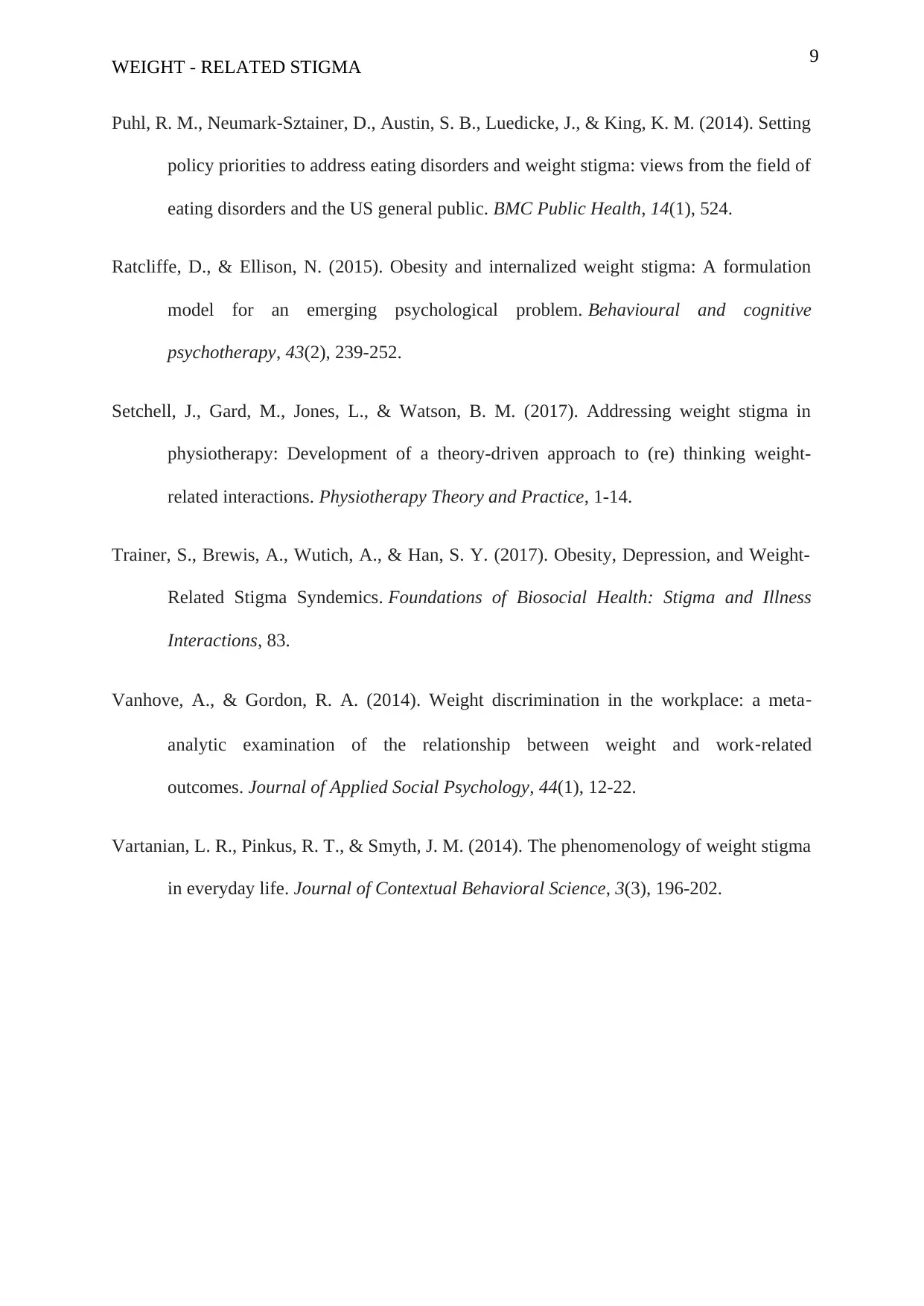
9
WEIGHT - RELATED STIGMA
Puhl, R. M., Neumark-Sztainer, D., Austin, S. B., Luedicke, J., & King, K. M. (2014). Setting
policy priorities to address eating disorders and weight stigma: views from the field of
eating disorders and the US general public. BMC Public Health, 14(1), 524.
Ratcliffe, D., & Ellison, N. (2015). Obesity and internalized weight stigma: A formulation
model for an emerging psychological problem. Behavioural and cognitive
psychotherapy, 43(2), 239-252.
Setchell, J., Gard, M., Jones, L., & Watson, B. M. (2017). Addressing weight stigma in
physiotherapy: Development of a theory-driven approach to (re) thinking weight-
related interactions. Physiotherapy Theory and Practice, 1-14.
Trainer, S., Brewis, A., Wutich, A., & Han, S. Y. (2017). Obesity, Depression, and Weight-
Related Stigma Syndemics. Foundations of Biosocial Health: Stigma and Illness
Interactions, 83.
Vanhove, A., & Gordon, R. A. (2014). Weight discrimination in the workplace: a meta‐
analytic examination of the relationship between weight and work‐related
outcomes. Journal of Applied Social Psychology, 44(1), 12-22.
Vartanian, L. R., Pinkus, R. T., & Smyth, J. M. (2014). The phenomenology of weight stigma
in everyday life. Journal of Contextual Behavioral Science, 3(3), 196-202.
WEIGHT - RELATED STIGMA
Puhl, R. M., Neumark-Sztainer, D., Austin, S. B., Luedicke, J., & King, K. M. (2014). Setting
policy priorities to address eating disorders and weight stigma: views from the field of
eating disorders and the US general public. BMC Public Health, 14(1), 524.
Ratcliffe, D., & Ellison, N. (2015). Obesity and internalized weight stigma: A formulation
model for an emerging psychological problem. Behavioural and cognitive
psychotherapy, 43(2), 239-252.
Setchell, J., Gard, M., Jones, L., & Watson, B. M. (2017). Addressing weight stigma in
physiotherapy: Development of a theory-driven approach to (re) thinking weight-
related interactions. Physiotherapy Theory and Practice, 1-14.
Trainer, S., Brewis, A., Wutich, A., & Han, S. Y. (2017). Obesity, Depression, and Weight-
Related Stigma Syndemics. Foundations of Biosocial Health: Stigma and Illness
Interactions, 83.
Vanhove, A., & Gordon, R. A. (2014). Weight discrimination in the workplace: a meta‐
analytic examination of the relationship between weight and work‐related
outcomes. Journal of Applied Social Psychology, 44(1), 12-22.
Vartanian, L. R., Pinkus, R. T., & Smyth, J. M. (2014). The phenomenology of weight stigma
in everyday life. Journal of Contextual Behavioral Science, 3(3), 196-202.
1 out of 10
Related Documents
Your All-in-One AI-Powered Toolkit for Academic Success.
+13062052269
info@desklib.com
Available 24*7 on WhatsApp / Email
![[object Object]](/_next/static/media/star-bottom.7253800d.svg)
Unlock your academic potential
Copyright © 2020–2025 A2Z Services. All Rights Reserved. Developed and managed by ZUCOL.





